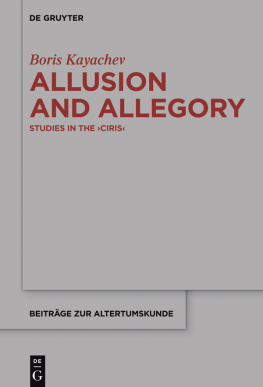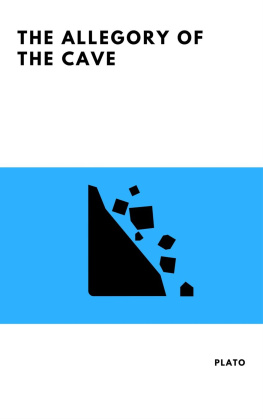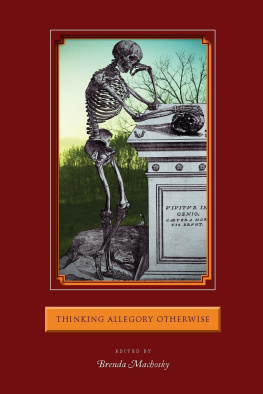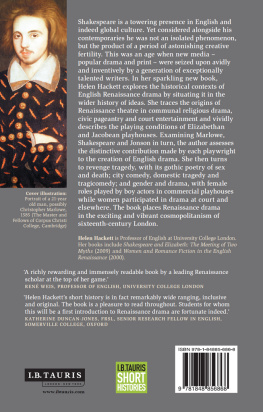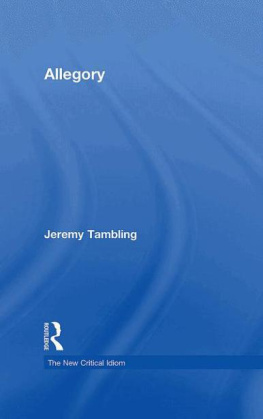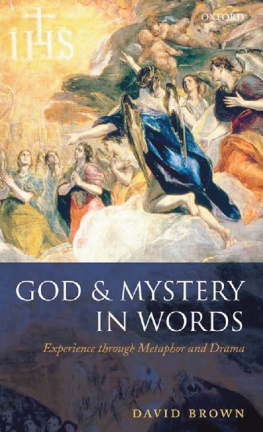The Persistence of Allegory

The Persistence of Allegory
Drama and Neoclassicism from
Shakespeare to Wagner
JANE K. BROWN

Copyright 2007 University of Pennsylvania Press
All rights reserved
Printed in the United States of America on acid-free paper
10 9 8 7 6 5 4 3 2 1
Published by
University of Pennsylvania Press
Philadelphia, Pennsylvania 19104-4112
Library of Congress Cataloging-in-Publication Data
Brown, Jane K., 1943
The persistence of allegory : drama and neoclassicism from Shakespeare to Wagner / Jane K. Brown.
p. cm
Includes bibliographical references and index.
ISBN-13: 978-0-8122-3966-9
ISBN-10: 0-8122-3966-0
1. European dramaHistory and criticism. 2. Neoclassicism (Literature)Europe. I. Title.
PN1811.B76 2006
2006042173
Frontispiece: Andrea Mantegna, Minerva Chasing the Vices from the Garden of Virtue.
Runion des Muses Nationaux/Art Resource, Paris.
For my mothers, Gertrude and Hermione
Gestaltung, Umgestaltung,
Des ewigen Sinnes ewige Unterhaltung.
Contents
Preface
In todays climate of culture studies and globalism, some explanation for a book focused on the forms of the European literary past seems to be in order. The short answer is that synthesizing our knowledge of the history of drama in Europe since the Renaissance changes unreflected assumptions into which we all relapse from our immediate specialties and that are widespread outside the academy. A more reflected relation to what seems obvious to us and closest to home might, by alienating our tradition, make it more understandable in the global context within which our disciplines now aspire to understand it.
The longer answer comes from the circumstances surrounding the genesis of the book. My training and early career were in German Baroque and eighteenth century, especially Goethe. When I moved to the English Department at the University of Colorado in 1979 to keep my family together, I was writing a book on Faust and found myself teaching Shakespeare. I soon learned that my German Romantic take on the Renaissance led to equally vehement, but contradictory, reactions: either that there is no allegory in Shakespeare or that allegory and Shakespeares medieval roots are old hat. As I learned more about Shakespeare, about Ben Jonson as a writer of masques, and about their Spanish contemporary, Pedro Caldern de la Barca (also necessary to understand Faust), I decided my next book would be about allegorical dramaThe Other Drama I wanted to call it.
The area has in fact been well studied, but the people who study its different parts dont talk much to one another. Despite the establishment of comparative literature as a discipline more than a generation ago, non-German scholars interested in Benjamin on allegory do not read German Baroque drama (nor indeed do most German scholars interested in Benjamin, nor do scholars of seventeenth-century drama in other European traditions), nor do they read Caldern, despite Benjamins strong emphasis on him, much less the obscurer eighteenth-century texts, the Haupt- und Staatsaktionen, to which he points. Nor do they read these people next to the great French dramatists or, with rare exceptions, English dramatists of the century, let alone their great Dutch contemporary, Joost van den Vondel. In the last decade or so scholars have become more interested in opera, but opera in the seventeenth and even eighteenth centuries is, for all practical purposes, an entirely separate field from drama. I was soon learning all kinds of information that was surprising to friends, students, and colleagues in adjacent specialties, even when it was familiar to specialists. And so arose my central thesis: the history of European drama is a unity, and it is necessary to read it across the boundaries of languages and subgenres.
In the process I learned there really was no other drama. Given the prejudices of Goethe and his friends, for whom French neoclassicism was the Antichrist, I had assumed that my other drama was allegorical and neoclassical drama mimetic. Writing this book, I learned that both kinds emerged from the same primal soup, from Western Europes repeated efforts to reinvent itself by returning to classical antiquity. The last thing I had in mind at the start was to rewrite the history of neoclassicism, but that is precisely what this book proposesthat we think of neoclassicism not as a single movement, but as a wave of interrelated movements that sometimes further and sometimes retard one another. Now I was really not writing about allegorical drama, but about all European drama from Shakespeare to Wagner.
To be sure, this is not a comprehensive synthetic history of European drama; instead I trace the development by its evolving skeleton. I am interested in the forms that underlie and enable the conventions of European drama. Others might call the goal structuralist, but I would prefer to think of it as morphological in Goethes sense of the word. The coverage is broad but selective; I have not shied away from synthesizing information any specialist would know, yet I have tried to avoid what nonspecialists will already take for granted, such as demonstrating the structural richness and psychological insight of Shakespeare or Racine. I have tried instead to introduce the materials from a point of view less obvious to most readers, and I have often turned to dramatists of great interest who are less well known, at least in my cultural context, than they deserve. I hope that by repositioning the familiar dramatists in an other seventeenth- and eighteenth-century context, both dramatists and context will gain in depth.
I also hope that readers will come to share my view of the subliminal unity of European drama since the late Middle Ages across national and historical boundaries, and even across the boundaries of different arts. I have no wish to undo generations of careful and important work analyzing the distinctions among different forms of theater art and understanding the relation of those forms to historical and cultural circumstances, but rather hope the distinctions will take on richer meaning when understood as variations from a constant underlying possibility. Even more, I hope readers will appreciate the unexpected historical and formal diversity of both neoclassicism and allegory that I have tried to make visible. Both phenomena must be understood historically, not as fixed categories. While under certain circumstances it is useful to think about allegory as a static mode in the still-helpful terms of Angus Fletcher, it is also necessary to understand it as a phenomenon that varies historically and generically. It is possible to use the term allegory about such different figures as Shakespeare, Claude Lorrain, Goethe, or even Ibsen without leveling them to a simplified understanding of medieval allegory. It also means that all texts should be read, to different extents for different texts, allegorically, whether dramas, operas, narratives of whatever sort, not just certain kinds of arcane novels and a historically and generically specified subset of dramatic works called morality play or masque. And conversely, there is a real historical basis for allegorical reading that validates it as more than just the preference of a particular kind of reader.
This work has benefited from the generosity of more people than I can name here. First, I must thank above all my former colleagues at the University of Colorado, especially but not only Everly Fleischer, Elissa Guralnick, Jim Kincaid, Paul Levitt, and Ruth Widmann. There was nothing obvious about hiring me in an English Department or letting me teach the Renaissance; I appreciate both the imagination and tolerance that provided me such a constructive working environment for nine years and hope the department felt it received some adequate return. Second, I am grateful to all the students at Colorado, Washington, Munich, and Tbingen who have joined me in exploring new, sometimes rather arcane, areas over the last twenty years. Third, I owe an enormous debt to my colleagues at Washington and elsewhere who supported this work for so many years with opportunities to teach this material, letters of recommendation, and generous research leaves. The work was supported at different times by the University of Washington Royalty Research Fund, the Walter Chapin Simpson Humanities Center at the University of Washington, and a year-long fellowship from the National Endowment for the Humanities; I am deeply grateful to all of these institutions.
Next page

